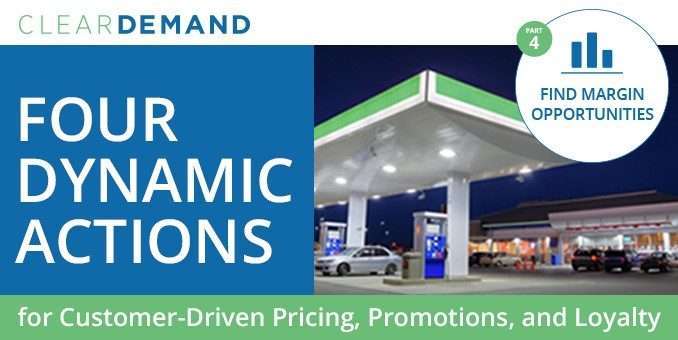
In the convenience store sector, everyday price optimization is seldom the option of first resort. As we discussed in prior articles in this series, rules management may often be the first line of action for C-stores. This is especially so in complex and highly-regulated categories such as tobacco and beer.
It may seem reasonable, then, to conclude that for C-Stores the majority of the financial benefits from an advanced pricing management system would stem from rigorous compliance, in-store implementation and well-designed promotions. These disciplines are indeed necessary, but they are not entirely sufficient.
Why is it important for C-Stores to also pursue everyday price optimization? In a word, profits.
In a landmark paper published in 1992, Michael V. Marn and Robert L. Rosiello reported that a 1 percent aggregate increase in prices, assuming no change in volume, can boost operating profits by 11.1 percent (“Managing Price, Gaining Profit,” in Harvard Business Review, September-October 1992, pp. 84-93).
The authors calculated that this effect is far greater than the increases a company can expect from a 1 percent overall reduction in variable costs (7.8 percent), a 1 percent reduction in fixed costs (2.3 percent), or a 1 percent increase in volume (3.3 percent).
For C-Stores, every-day price optimization is a complementary business activity, not a substitute for rules management. Since many pricing decisions in convenience stores are constrained, it is especially important to systematically identify where margin opportunities are available on the remainder of the assortment. Demand modeling, powered by machine learning, is the preferred tool for the job.
The term describes “the use of a mathematical model to determine the most profitable price for a good or service based on historical information on customers, marketplace and competitors,” (Larry Montan, Terry Kuester, Julie Meehan, “Getting Pricing Right – The value of a multifaceted approach”, Deloitte Review, Issue 3, 2008).
The authors continue: “A price optimization model can not only help management select an appropriate price, but also estimate the probable outcome of any pricing changes.”
Reliable forecasting of how demand will be affected when a price is changed is therefore a core element of modern pricing systems.
What items should C-Stores optimize?
All retailers know intuitively that a higher price increases gross margin, but if it causes unit volume to drop, the bottom line may be negatively affected. Conversely, a significantly lower price may boost unit volume greatly but depress total profits.
Price optimization science applies mathematical modelling to set item prices based on analysis of shopper demand. The micro-economic principle applies in general – higher prices are expected to result in lower unit sales, and vice versa. The degree of sensitivity for a particular item, line, or category is known as its price elasticity.
Elasticity of response typically varies at the category and item level. Changes in price up or down can increase or decrease the quantity sold or sometimes have no effect on demand.
For one item in isolation, it’s a straightforward matter to select the price point that delivers the desired balance of volume versus profit. We can plot an “opportunity curve” that shows this relationship. The goal is to identify the price point that delivers the desired outcome of unit sales and total profitability.
The pricing model is derived from an analysis of several years of POS and basket data, shopper loyalty data, competitor pricing data, promotional response data and other inputs across a store’s entire product line. It also accounts for numerous interaction effects – how a pricing decision on one item may affect take-away on other items:
- Cannibalization effect occurs when a rise in sales of one item leads to reduced sales of another item. A sharp price on chocolate milk might take sales away from other soft drinks, for example.
- Halo effect occurs when higher unit sales of an item result in higher sales of another item. A great price on coffee may be associated with higher volume on breakfast pastries, for example.
Interaction effects are numerous and they may be less intuitive than these simple examples. Do higher salty snack sales cannibalize candy bars but increase sales of bottled soft drinks? Do fountain drink sales drive halo sales of sandwiches or pizza?
Items in other categories, like automotive products or sundries, may exhibit lower price sensitivity and few or no interactions.
Since this is complex, machine learning is required to identify opportunity items that may be candidates for price adjustment. The model can reveal which items are likely to be more sensitive to price increases and which items may be candidates for a few cents more margin.
Pursue optimization mindfully
It may be tempting for a C-Store operator to simply raise prices one percent across the board to gain the 11% profit boost promised by that classic HBR article. Items and categories play varying roles within your total merchandising strategy, however. Some may indeed drive profits, while others drive basket size or send a competitive message.
A few highly-visible prices can make or break your price image. Aim too high on a known-value item (KVI) and your shoppers may conclude that your entire store is expensive. Aim too low and you sacrifice margins and make it harder to raise prices later.
Price inconsistently across a line or within a category and shoppers may be confused or suspicious. Price too far above your competitors and you may miss a purchase – and never learn why. Price too far below a competitive item and you leave money on the table.
Price image translates to shopper trust, which is the foundation of loyalty and the pathway to increased visits, larger baskets and more profitable transactions.
